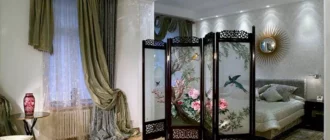Pop art in the interior is an extravagant style of interior design, which is characterized by an abundance of decor, bold color palette, and original accessories. Pop art denies the gray dull routine, monotony, strict rules and forms. Daring and screaming, he breaks stereotypes, conveys the mood of an eternal holiday.
Pop art in the interior has a wide range of saturation with colors and decor: from an overabundance of color, sometimes pretentiousness and aggressiveness in a room to more moderate, restrained, almost calm options with a limited number of bright elements. It goes well with many modern styles: contemporary, Scandinavian, hi-tech, minimalism, loft. Dilutes them with a bright eccentric palette, maintaining moderation and harmony.
The main characteristics and features of the pop art style in the interior
Pop art in the interior is a catchy, attention-grabbing space. It is often confused with kitsch, which embodies a rebellious spirit, laughs at age-old traditions, but has no stylistic focus, and brings dissonance and cacophony into the interior. If pop art is brightness, then kitsch is an imitation of luxury, a tasteless combination of incongruous elements.
Pop art room design is not complete without decor. Design objects and objects of mass culture are used as attributes. The most popular subjects are taken from movies, music, advertising.
The main characteristic are:
- reproductions of paintings;
- illustrations of comics;
- posters;
- posters;
- panel;
- collages;
- photographs in unusual frames;
- vinyl records;
- souvenirs.
In the pop-art interior, stretch ceilings with a glossy shine, mirror panels, visually expanding the space, look attractive.
It is also allowed to use natural and artificial materials of different texture:
- plastic;
- metal;
- paper;
- cardboard;
- mirrors;
- glass;
- skin;
- furs.
Preference is given to asymmetric multi-level structures, which are often used in the design of floors and ceilings. They allow you to combine gloss and dullness in niches and ledges, create an extraordinary atmosphere.
For a pop art style in an interior, full lighting is required. Lamps can be simple point, or completely unimaginable in shape: curved, curved, depicting cult heroes. In the design you can see club systems: mirror balls, LED spotlights. Original hand made lamps, created from improvised means: discs, cans, glass, and sometimes even plastic bottles, are appropriate.
A pop-art interior is not complete without acidity. It uses rich and super-bright shades: ultramarine, pink, yellow, green. Contrasting colors are used for wall decoration. Neon shades are allowed. Each wall can act as an independent art object in a common space. For example, one is decorated in a classic light color scheme, the other is replete with ornaments, the rest are covered with bright colors. Optical illusions and patterns made in different palettes look interesting on the walls.
There are no clear requirements for furniture. But she must attract attention with her uniqueness:
- heart-shaped beds;
- chairs with curved legs;
- armchairs depicting bowls or lips;
- racks and shelves that combine different colors.
The modern interior in the style of pop art is suitable for extraordinary creative personalities, experimenters, dreamers and those who are tired of the monochrome gray everyday life. He is often chosen by young ambitious people with non-trivial taste, irony and a sense of humor.
History
The history of the origin of the pop art style in the interior dates back to the 50s of the last century. In the era of post-war economic growth in Western Europe, Britain and the United States, as a counterbalance to the “consumer society”, the popular fine art of the same name began to emerge. It received the greatest development in America and there for the first time went beyond the boundaries of art galleries and exhibitions, migrating to houses, apartments, clubs.
The popular design reflected the consumer culture of the time, in keeping with America’s rise. In the interiors, posters, posters, popular comics were imitated, slogans, collages from newspapers, magazines, photographs were used. Essentially a satire, the style represented the consumer ideal of the average American.
Over time, the concept of style has not changed. But there are new images of mass culture, modern innovative materials, decorative components. The design of the premises has taken on a different look, different from the interiors with popular artifacts from 70 years ago.



















